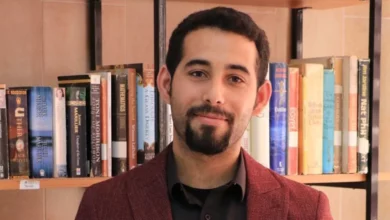The first question Samar Ali’s English poetry collection Tannoura (Malameh Publishing House, 2008) is expected to pose is the choice of language. A few years ago, I would have looked with suspicion on Egyptian writers choosing a language other than their native tongue as their medium, with the clear exception of Ahdaf Soueif since she has declared that her creative self “cannot” express itself in Arabic as fluently as it does in the language of her education.
Lately, I changed my mind, since what applies to Soueif applies as well to younger writers in the same difficult position. In the global world of today, one needs to realize the existence of a generation who has had a bilingual education and who would rather write in a “foreign” language that has become no longer foreign. Needless to say, their numbers are growing. Accordingly, the basic criteria one needs to apply is how far this writing expresses an “Egyptian” identity as well as how good the writing is.
Samar Ali’s poetry collection Tannoura first presents itself to its reader through the title, which is no foreign concept. “Tannoura” is the dance of Jalal Din Rumi’s dervishes. Rumi, the 13th century Persian Sufi, has endowed the dance with transcendental dimensions, making it a metaphor for the individual’s attempts to rise in consciousness to the divine realm. “El-Tannoura” has been integrated within Egyptian culture as an Egyptian folk dance derived from the whirling dance of the dervishes. The word “tannoura” may refer to the dance or the dancer, as well as the large colourful skirt melting into white with the dancer’s circular movements.
Samar Ali’s poetic world plays on the three levels of the word as much as the book moves on three tracks, circular, like the move of the dancers, rather than parallel. Though each of the three sections of the book registers a step forward in the persona’s journey, certain feelings and conflicts are reiterated, hence the circular nature of the book. The first section “Violet” explores the images and sense of alienation experienced by the female persona. “Plum,” a lighter reddish shade, moves towards hope. Then comes “Lavender,” the lightest of all shades and the colour most associated with the soul and its transcendence to a higher plane of existence.
In “Violet,” the reader is driven down to the dungeon where the persona suffers imprisonment within four walls, where “she stretches a leg to the east and the other/ to the west,/ But can’t smell the cinnamon or taste the/air.” Images of cold, boredom, tears, death, and loneliness permeate.
Yet
You can’t sing
Your old notes no more,
Or feel the rain
Like you did before.
(“Hollow Shell”)
Amid the darkness, the yearning persists not just for the long dreamt-of love, but also for companionship that is found among Hathour’s “Priestesses,/Carrying the flame of eternity.” A good enough note of resistance, a move from a state of complaining to one of seeking. Significantly, this note comes in “Hathour,” the final poem of the first section, thus acting as a bridge to the next phase of the journey.
In the reddish world of the second section, “Plum,” a stronger resistance on the part of the persona eventually lights up the world of Tannoura with rays of hope, neither too bright nor too sudden. The cold of alienation of the first section ebbs slowly, leaving space for brighter colors to enter the scene. Now “a full moon,/painted on the dark horizon” appears, the night is “rosy,” tomorrow is “cyan” blue and the reader enters the world of “Divine Green.” The world of this part still carries the scent of sorrow, yet a new attitude of defiance is already making way. This is manifested, for instance, in the male/female “Amusing War” which ends on this note:
Arrange your bouquet,
Wear your agonizing perfume.
Put on your appealing jacket,
Smile & turn around.
The velvet blossom with glowing petals,
Heavenly releasing a golden aura,
Waved goodbye a while ago.
Though the female persona of Tannoura never points an accusing finger at social pressures on Egyptian women, her mood swings and conflicts speak a message. Another note is delivered to young women of a similar position. It is about opening up wounds as a first step towards healing them, and about shedding all the hidden tears but never losing sight of the power within which carries the promise of a possible salvation. In Tannoura, this inner power is tapped through images drawn from nature as well as from Egyptian goddesses like Hathour and Ma’et.
I am intentionally leaving the Tannoura jigsaw incomplete by not touching on the “Lavender” of the last section. I urge interested readers to complete it for themselves.




